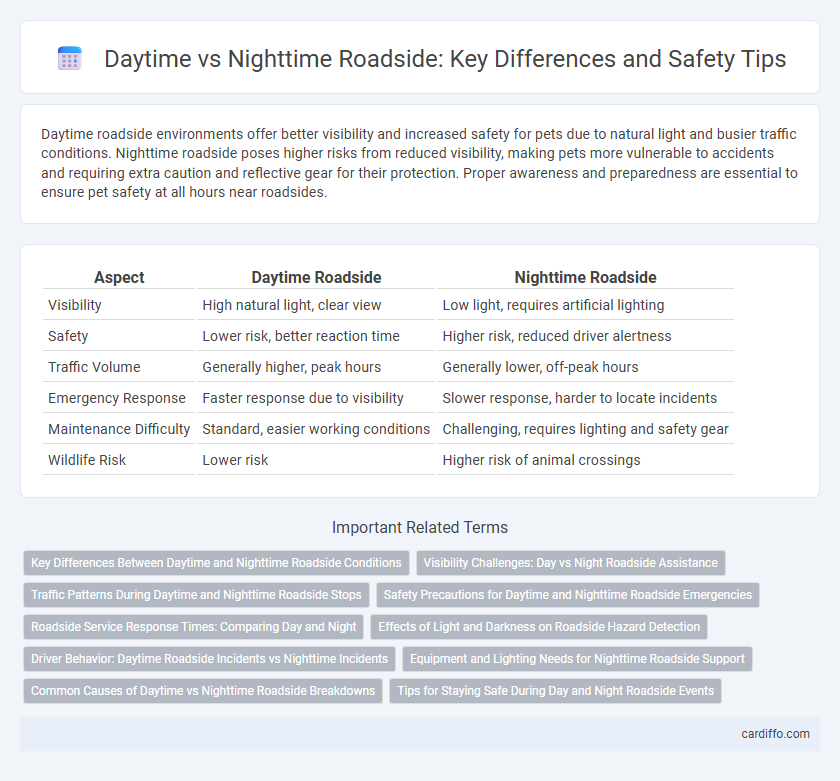Daytime roadside environments offer better visibility and increased safety for pets due to natural light and busier traffic conditions. Nighttime roadside poses higher risks from reduced visibility, making pets more vulnerable to accidents and requiring extra caution and reflective gear for their protection. Proper awareness and preparedness are essential to ensure pet safety at all hours near roadsides.
Table of Comparison
| Aspect | Daytime Roadside | Nighttime Roadside |
|---|---|---|
| Visibility | High natural light, clear view | Low light, requires artificial lighting |
| Safety | Lower risk, better reaction time | Higher risk, reduced driver alertness |
| Traffic Volume | Generally higher, peak hours | Generally lower, off-peak hours |
| Emergency Response | Faster response due to visibility | Slower response, harder to locate incidents |
| Maintenance Difficulty | Standard, easier working conditions | Challenging, requires lighting and safety gear |
| Wildlife Risk | Lower risk | Higher risk of animal crossings |
Key Differences Between Daytime and Nighttime Roadside Conditions
Daytime roadside conditions feature higher visibility, natural daylight, and increased pedestrian and vehicular traffic, enhancing safety and operational efficiency. Nighttime roadside environments experience reduced visibility, reliance on artificial lighting, and greater risks from fatigue and impaired drivers, necessitating enhanced caution and reflective safety measures. Temperature fluctuations and wildlife activity also differ, impacting roadside maintenance and emergency response protocols.
Visibility Challenges: Day vs Night Roadside Assistance
Daytime roadside assistance benefits from natural sunlight that enhances visibility, enabling quicker identification of hazards and vehicle issues. Nighttime roadside situations present significant visibility challenges due to darkness, requiring the use of high-visibility clothing, portable lighting, and reflective equipment to ensure safety. Advanced LED road flares and illuminated warning triangles improve nighttime roadside safety by increasing visibility for both rescuers and passing motorists.
Traffic Patterns During Daytime and Nighttime Roadside Stops
Daytime roadside stops experience higher vehicle volumes due to rush hours, increased commercial traffic, and frequent pedestrian activity, resulting in more congestion and quicker turnover at rest areas. Nighttime roadside stops typically see reduced traffic flow, with fewer commercial vehicles and diminished pedestrian presence, enabling longer stops and less congestion. Traffic patterns during daytime prioritize safety measures for increased visibility and crowded conditions, whereas nighttime stops demand enhanced lighting and security to accommodate limited visibility and isolated environments.
Safety Precautions for Daytime and Nighttime Roadside Emergencies
Daytime roadside emergencies require high-visibility clothing and placement of reflective warning triangles at least 100 meters from the vehicle to alert oncoming traffic. Nighttime roadside safety precautions emphasize the use of bright, portable LED flares or flashing lights, along with a flashlight to increase visibility and reduce accident risks. Proper vehicle positioning away from traffic lanes and immediate communication with emergency services are critical regardless of the time of day.
Roadside Service Response Times: Comparing Day and Night
Daytime roadside service response times are typically faster due to higher availability of technicians and clearer road conditions, averaging around 20-30 minutes. Nighttime response times can extend to 40-60 minutes, influenced by limited staff and reduced visibility affecting service efficiency. Urban areas often experience shorter wait times compared to rural locations regardless of the time of day.
Effects of Light and Darkness on Roadside Hazard Detection
Daytime roadside conditions enhance hazard detection due to natural light, improving visibility of obstacles and road signs for drivers. Nighttime roadside environments rely heavily on artificial lighting and vehicle headlights, which can create shadows and glare, reducing the ability to identify hazards quickly. The contrast between light and darkness significantly impacts driver reaction times and overall roadside safety.
Driver Behavior: Daytime Roadside Incidents vs Nighttime Incidents
Daytime roadside incidents frequently involve distracted drivers and higher traffic volumes, leading to increased stop-and-go behaviors and sudden lane changes. Nighttime roadside incidents often result from reduced visibility, driver fatigue, and impaired driving, which contribute to slower reaction times and higher likelihood of collisions. Studies show that nighttime incidents have a higher fatality rate despite lower overall traffic density compared to daytime incidents.
Equipment and Lighting Needs for Nighttime Roadside Support
Nighttime roadside operations require specialized lighting equipment such as portable floodlights, LED work lamps, and reflective safety markers to ensure visibility and safety for both workers and passing vehicles. High-intensity, battery-powered lighting systems are essential for illuminating accident scenes, road repairs, and vehicle recovery in low-light conditions. Specialized safety gear with built-in illumination further enhances the effectiveness of nighttime roadside support by improving worker visibility and reducing accident risks.
Common Causes of Daytime vs Nighttime Roadside Breakdowns
Daytime roadside breakdowns commonly result from overheating engines, battery failures due to extended accessory use, and tire blowouts caused by increased heat and road debris. Nighttime breakdowns are often attributed to reduced visibility leading to accidents, dead batteries from lights or electrical systems left on, and fuel depletion due to poor fuel gauge visibility. Both conditions require distinct preventive measures to reduce roadside emergencies effectively.
Tips for Staying Safe During Day and Night Roadside Events
Visibility drastically decreases at nighttime roadside events, increasing the risk of accidents due to limited sight and reduced driver awareness. Reflective clothing, bright warning signs, and effective lighting are essential for nighttime safety, while daytime safety relies more on high-visibility vests and clear positioning away from traffic flow. Staying alert, minimizing distractions, and positioning oneself well off the travel lanes improve safety during both day and night roadside situations.
Daytime roadside vs nighttime roadside Infographic

 cardiffo.com
cardiffo.com